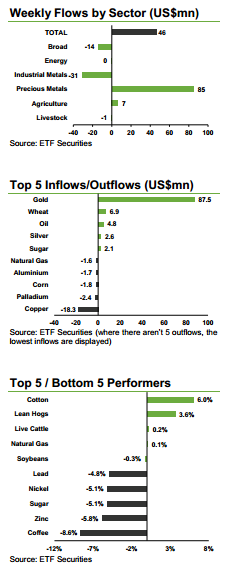Analys
Oil and gold remain top trades as bargain hunting drives flows

 Gold and oil ETPs both respectively saw their 9th consecutive week of inflows. The price of gold and oil has fallen in recent weeks, in part reflecting a reduction in the geopolitical premium following a ceasefire agreed by Ukraine and Russia. Bargain hunting investors have chosen to increase their holdings of oil with its price looking particularly attractive, with both Brent and WTI oil benchmarks trading below US$100/bbl. We believe OPEC is likely to cut production if demand for oil continues to remain weak, which will in turn help support prices. Despite weakness in gold prices, investors have generally maintained holdings over the past few months. Daily flow data however indicates that some investors are losing patience with gold in recent days and its weak price could test the endurance of some investors if the relatively stable geopolitical situation lasts.
Gold and oil ETPs both respectively saw their 9th consecutive week of inflows. The price of gold and oil has fallen in recent weeks, in part reflecting a reduction in the geopolitical premium following a ceasefire agreed by Ukraine and Russia. Bargain hunting investors have chosen to increase their holdings of oil with its price looking particularly attractive, with both Brent and WTI oil benchmarks trading below US$100/bbl. We believe OPEC is likely to cut production if demand for oil continues to remain weak, which will in turn help support prices. Despite weakness in gold prices, investors have generally maintained holdings over the past few months. Daily flow data however indicates that some investors are losing patience with gold in recent days and its weak price could test the endurance of some investors if the relatively stable geopolitical situation lasts.
 Bargain hunting drove US$7.4mn into long oil ETPs, marking the longest stretch of weekly inflows since 2012. Although bets weren’t completely one-sided, with US$2.7mn of inflows into short oil ETPs, many investors are doubtful that the current weakness in oil price can persist. Weak global demand for oil products this summer, combined with the limited impact of geopolitical risks on OPEC and Russian oil supply sent both Brent and WTI prices to multi-month lows. With production reaching multi-decade highs, US oil inventories had remained above its 5-year range until very recently and stockpiles at Cushing have been slowly rebuilding. While Chinese oil imports and the US summer driving season have not been as supportive of oil demand as expected, the US Energy Information Agency (EIA) is forecasting a supply deficit for the second half of 2014 and OPEC is anticipating a pick-up in global oil demand during the remaining months of 2014. Should that pick-up in demand not materialise, we believe that OPEC will cut production from its current target of 30mb/d.
Bargain hunting drove US$7.4mn into long oil ETPs, marking the longest stretch of weekly inflows since 2012. Although bets weren’t completely one-sided, with US$2.7mn of inflows into short oil ETPs, many investors are doubtful that the current weakness in oil price can persist. Weak global demand for oil products this summer, combined with the limited impact of geopolitical risks on OPEC and Russian oil supply sent both Brent and WTI prices to multi-month lows. With production reaching multi-decade highs, US oil inventories had remained above its 5-year range until very recently and stockpiles at Cushing have been slowly rebuilding. While Chinese oil imports and the US summer driving season have not been as supportive of oil demand as expected, the US Energy Information Agency (EIA) is forecasting a supply deficit for the second half of 2014 and OPEC is anticipating a pick-up in global oil demand during the remaining months of 2014. Should that pick-up in demand not materialise, we believe that OPEC will cut production from its current target of 30mb/d.
Long wheat ETPs saw their 17th consecutive week of inflows as investors mounted bets on a less bearish USDA report. After months of successive production and stock upgrades, some investors thought that last Thursday’s World Agricultural Demand and Supply Estimate report would show some stabilisation. It turns out that they were disappointed. The price of wheat fell 4.2% last week alone and is now trading at the lowest level since 2010. With wheat priced for perfect growing conditions, any small hiccup in weather in major producing countries or an escalation in trade restrictions could drive a price rally. More bargain hunting is likely with prices at multi-year low levels.
Concern over China and supply prompted another week of outflows in industrial metal ETPs, marking the largest cumulative four week outflow since May 2013. Last week, US$9.1mn was redeemed from ETFS Industrial Metals (AIGI) basket and most long industrial metal ETPs saw outflows. Long copper ETPs in particular saw US$18.6mn of outflows. Industrial metal prices declined as jitters over the health of Chinese demand troubled investors and the probability of the Philippines following Indonesia’s lead in banning ore exports has lessened. By the end of the week, however, China reported strong credit growth for the past month, which should go a long way to ease concerns about its ability to drive demand for commodity-intensive house building and infrastructure construction.
Key events to watch this week. The Federal Reserve’s FOMC meeting will be the focus of market attention. The US central bank is expected to continue to taper its bond-buying programme at the current rate, which will only leave another meeting (after this week’s) before it announces a stop to more purchases. After a disappointing US payrolls report, the market will watch out for any changes in forward guidance that could signal rate changes slower than current market expectations.
Analys
Tightening fundamentals – bullish inventories from DOE

The latest weekly report from the US DOE showed a substantial drawdown across key petroleum categories, adding more upside potential to the fundamental picture.

Commercial crude inventories (excl. SPR) fell by 5.8 million barrels, bringing total inventories down to 415.1 million barrels. Now sitting 11% below the five-year seasonal norm and placed in the lowest 2015-2022 range (see picture below).
Product inventories also tightened further last week. Gasoline inventories declined by 2.1 million barrels, with reductions seen in both finished gasoline and blending components. Current gasoline levels are about 3% below the five-year average for this time of year.
Among products, the most notable move came in diesel, where inventories dropped by almost 4.1 million barrels, deepening the deficit to around 20% below seasonal norms – continuing to underscore the persistent supply tightness in diesel markets.
The only area of inventory growth was in propane/propylene, which posted a significant 5.1-million-barrel build and now stands 9% above the five-year average.
Total commercial petroleum inventories (crude plus refined products) declined by 4.2 million barrels on the week, reinforcing the overall tightening of US crude and products.


Analys
Bombs to ”ceasefire” in hours – Brent below $70

A classic case of “buy the rumor, sell the news” played out in oil markets, as Brent crude has dropped sharply – down nearly USD 10 per barrel since yesterday evening – following Iran’s retaliatory strike on a U.S. air base in Qatar. The immediate reaction was: “That was it?” The strike followed a carefully calibrated, non-escalatory playbook, avoiding direct threats to energy infrastructure or disruption of shipping through the Strait of Hormuz – thus calming worst-case fears.

After Monday morning’s sharp spike to USD 81.4 per barrel, triggered by the U.S. bombing of Iranian nuclear facilities, oil prices drifted sideways in anticipation of a potential Iranian response. That response came with advance warning and caused limited physical damage. Early this morning, both the U.S. President and Iranian state media announced a ceasefire, effectively placing a lid on the immediate conflict risk – at least for now.
As a result, Brent crude has now fallen by a total of USD 12 from Monday’s peak, currently trading around USD 69 per barrel.
Looking beyond geopolitics, the market will now shift its focus to the upcoming OPEC+ meeting in early July. Saudi Arabia’s decision to increase output earlier this year – despite falling prices – has drawn renewed attention considering recent developments. Some suggest this was a response to U.S. pressure to offset potential Iranian supply losses.
However, consensus is that the move was driven more by internal OPEC+ dynamics. After years of curbing production to support prices, Riyadh had grown frustrated with quota-busting by several members (notably Kazakhstan). With Saudi Arabia cutting up to 2 million barrels per day – roughly 2% of global supply – returns were diminishing, and the risk of losing market share was rising. The production increase is widely seen as an effort to reassert leadership and restore discipline within the group.
That said, the FT recently stated that, the Saudis remain wary of past missteps. In 2018, Riyadh ramped up output at Trump’s request ahead of Iran sanctions, only to see prices collapse when the U.S. granted broad waivers – triggering oversupply. Officials have reportedly made it clear they don’t intend to repeat that mistake.
The recent visit by President Trump to Saudi Arabia, which included agreements on AI, defense, and nuclear cooperation, suggests a broader strategic alignment. This has fueled speculation about a quiet “pump-for-politics” deal behind recent production moves.
Looking ahead, oil prices have now retraced the entire rally sparked by the June 13 Israel–Iran escalation. This retreat provides more political and policy space for both the U.S. and Saudi Arabia. Specifically, it makes it easier for Riyadh to scale back its three recent production hikes of 411,000 barrels each, potentially returning to more moderate increases of 137,000 barrels for August and September.
In short: with no major loss of Iranian supply to the market, OPEC+ – led by Saudi Arabia – no longer needs to compensate for a disruption that hasn’t materialized, especially not to please the U.S. at the cost of its own market strategy. As the Saudis themselves have signaled, they are unlikely to repeat previous mistakes.
Conclusion: With Brent now in the high USD 60s, buying oil looks fundamentally justified. The geopolitical premium has deflated, but tensions between Israel and Iran remain unresolved – and the risk of missteps and renewed escalation still lingers. In fact, even this morning, reports have emerged of renewed missile fire despite the declared “truce.” The path forward may be calmer – but it is far from stable.
Analys
A muted price reaction. Market looks relaxed, but it is still on edge waiting for what Iran will do

Brent crossed the 80-line this morning but quickly fell back assigning limited probability for Iran choosing to close the Strait of Hormuz. Brent traded in a range of USD 70.56 – 79.04/b last week as the market fluctuated between ”Iran wants a deal” and ”US is about to attack Iran”. At the end of the week though, Donald Trump managed to convince markets (and probably also Iran) that he would make a decision within two weeks. I.e. no imminent attack. Previously when when he has talked about ”making a decision within two weeks” he has often ended up doing nothing in the end. The oil market relaxed as a result and the week ended at USD 77.01/b which is just USD 6/b above the year to date average of USD 71/b.

Brent jumped to USD 81.4/b this morning, the highest since mid-January, but then quickly fell back to a current price of USD 78.2/b which is only up 1.5% versus the close on Friday. As such the market is pricing a fairly low probability that Iran will actually close the Strait of Hormuz. Probably because it will hurt Iranian oil exports as well as the global oil market.
It was however all smoke and mirrors. Deception. The US attacked Iran on Saturday. The attack involved 125 warplanes, submarines and surface warships and 14 bunker buster bombs were dropped on Iranian nuclear sites including Fordow, Natanz and Isfahan. In response the Iranian Parliament voted in support of closing the Strait of Hormuz where some 17 mb of crude and products is transported to the global market every day plus significant volumes of LNG. This is however merely an advise to the Supreme leader Ayatollah Ali Khamenei and the Supreme National Security Council which sits with the final and actual decision.
No supply of oil is lost yet. It is about the risk of Iran closing the Strait of Hormuz or not. So far not a single drop of oil supply has been lost to the global market. The price at the moment is all about the assessed risk of loss of supply. Will Iran choose to choke of the Strait of Hormuz or not? That is the big question. It would be painful for US consumers, for Donald Trump’s voter base, for the global economy but also for Iran and its population which relies on oil exports and income from selling oil out of that Strait as well. As such it is not a no-brainer choice for Iran to close the Strait for oil exports. And looking at the il price this morning it is clear that the oil market doesn’t assign a very high probability of it happening. It is however probably well within the capability of Iran to close the Strait off with rockets, mines, air-drones and possibly sea-drones. Just look at how Ukraine has been able to control and damage the Russian Black Sea fleet.
What to do about the highly enriched uranium which has gone missing? While the US and Israel can celebrate their destruction of Iranian nuclear facilities they are also scratching their heads over what to do with the lost Iranian nuclear material. Iran had 408 kg of highly enriched uranium (IAEA). Almost weapons grade. Enough for some 10 nuclear warheads. It seems to have been transported out of Fordow before the attack this weekend.
The market is still on edge. USD 80-something/b seems sensible while we wait. The oil market reaction to this weekend’s events is very muted so far. The market is still on edge awaiting what Iran will do. Because Iran will do something. But what and when? An oil price of 80-something seems like a sensible level until something do happen.
-

 Nyheter4 veckor sedan
Nyheter4 veckor sedanUppgången i oljepriset planade ut under helgen
-

 Nyheter3 veckor sedan
Nyheter3 veckor sedanMahvie Minerals växlar spår – satsar fullt ut på guld
-

 Nyheter4 veckor sedan
Nyheter4 veckor sedanLåga elpriser i sommar – men mellersta Sverige får en ökning
-

 Nyheter2 veckor sedan
Nyheter2 veckor sedanOljan, guldet och marknadens oroande tystnad
-

 Nyheter2 veckor sedan
Nyheter2 veckor sedanJonas Lindvall är tillbaka med ett nytt oljebolag, Perthro, som ska börsnoteras
-

 Analys4 veckor sedan
Analys4 veckor sedanVery relaxed at USD 75/b. Risk barometer will likely fluctuate to higher levels with Brent into the 80ies or higher coming 2-3 weeks
-

 Analys3 veckor sedan
Analys3 veckor sedanA muted price reaction. Market looks relaxed, but it is still on edge waiting for what Iran will do
-

 Nyheter2 veckor sedan
Nyheter2 veckor sedanDomstolen ger klartecken till Lappland Guldprospektering












